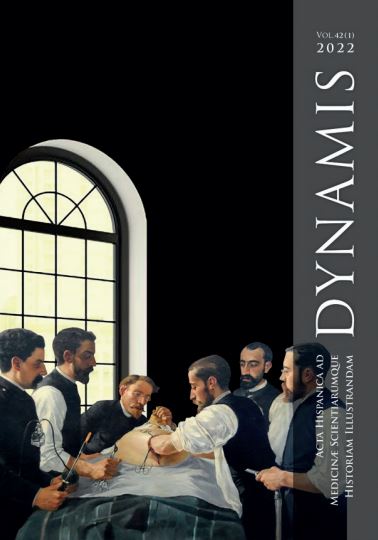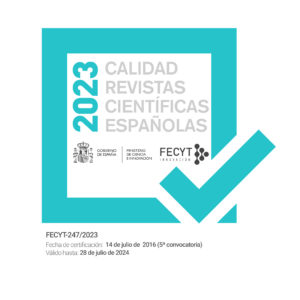Human experimentation with plutonium in Spain. Genesis and development of the “Indalo Project” (1966-2009)
DOI:
https://doi.org/10.30827/dynamis.v42i1.26896Keywords:
Indalo Project, human experimentation, plutonium contamination, Palomares accident, nuclear accidentAbstract
In 1966, four hydrogen bombs fell on the skies of Palomares (Alme- ria) after a B-52 bomber collided with its mothership. Each bomb was 68-foldmore powerful than the Hiroshima bomb, with three falling on land and one in the sea. The plutonium loads (Pu 239) of two of the three bombshitting land were spread over more than 100 hectares, mostly in the town of Palomares and its surrounds. A secret agreement was reached with the USA to study the inte- raction of plutonium with humans and the environment in the so-called Inda- lo Project. Plutonium had been discovered 26 years earlier, and its long-term consequences for humans remained unknown. The objective of this article is to describe the conditions, motivations, objectives, genesis, and development of the Indalo Project. This important and singular human experimentation project was not only enveloped in secrecy but also lacked any bioethical guarantee. Its creation was based on false official information about the complete decontami- nation of the area. The project was forged in dictatorship but maintained for 37 years in democracy, as revealed by the recent historiography in Spanish, eviden- ce in documentation available from the US Department of Energy (DOE), and oral accounts from affected individuals.
Downloads
References
Advisory Committee Human Radiation Experiments. “Oral Histories of Radiologist Hymer L. Friedell” (1995), consulta Nov. 9, 2020, https://ehss.energy.gov/ohre/roadmap/histories/0466/0466a.html
Álvarez Ramis, Concepción and Gregorides de los Santos, A. ”Contamination of terrestrial gasteropda in a biotope with low level alfa contamination due to plutonium and uranium”. Actes du Symposiun International de Radioecologie. Cadarache, Francia; (1969): 961-982.
Antón Mateos, M.ª Paz. “Dinámica sedimentaria de radionucleidos de vida larga en el litoral Mediterráneo occidental”, Phd. Diss, Universidad Complutense de Madrid, 2013.
Air Force Surgeon General’s Office. “Palomares Nuclear Weapons Accident. Revised Dose Evaluation Report” (Apr, 2001), consulta Nov 16, 2020,
https://www.documentcloud.org/documents/2797013-xxplutonium-2001-USAF-Revised-DoseEvaluation.html
Aznar Sánchez, J. A. and Sánchez Picón, A. “Inmigración en tierra de emigración: el caso de Almería”. Economistas18, n.º 86 (2000): 97-115.
Bair, W.J. and Thompson, R.C. “Plutonium: biomedical research. More is known about the toxicology of plutonium than about most other hazardous elements”. Science 183, n.º 4126 (1974): 715-722. https://doi.org/10.1126/science.183.4126.715
Bayea, Yan and Von Hippel, Frank. “History of dose, risk, and compensation assessments
for US veterans of the 1966 plutonium cleanup in Palomares, Spain”. Health Physics
, n.º 6 (Jul, 2019): 625-636. https://dx.doi.org/10.1097%2FHP.0000000000001103
Chanin, D.I. and Murfin, W.B. “Site Restoration Estimation of Attributable Cost from
Plutonium Dispersal Accident”, Sandia Co. (1996). https://doi.org/10.2172/249283
Capel Molina, José. “Génesis de las inundaciones de octubre de 1973 en el sureste de la Península Ibérica”. Cuadernos geográficos de la Universidad de Granada, n.º 2 (1974): 149-166.
Defense Atomic Support Agency [DASA], “Proceeding of the Second Interdisciplinary Conference on select effects of a general war”, vol. II (1969): 244.
De la Torre, Joseba. “Who was who in the making spanish nuclear programme c.1950-1985”, in The Economic History of Nuclear Energy in Spain, edited by M.ª del Mar RubioVaras. and Joseba De la Torre, 33-65. London: Palgrave Macmillan, Cham, 2017.
Espinosa, Asunción; Aragón, Antonio and De la Cruz, B. Estimación del Contenido de Americio existente en el año 1987 en una zona de Palomares contaminada en 1966 por material de plutonio grado bomba. Madrid: CIEMAT, 2001.
Florensa, Clara. “James Bond, Pepsi-Cola y el accidente nuclear de Palomares (1966)”, in: De la Guerra Fría al calentamiento global. Estados Unidos, España y el nuevo orden científico mundial, edited by Lino Camprubí,; Xavier Roqué, and Francisco Sáez de Adana, 17-38. Madrid: Catarata, 2018.
Gutiérrez, José et al. “Spanish experience in intervention at an accidentally contaminated site”. Proceedings of the Conference: On remediation and Restoration of Radioactive Contaminated Sites in Europe.Antwerp, Belgium (1993).
Herrera Plaza, José. Accidente nuclear de Palomares. Consecuencias (1966-2016) Mojácar: Arráez Editores, 2015.
Howard, John. The american nuclear cover-up in Spain. London: The British Library, 2017.
Iranzo, Emilio and Ramos, Eduardo. “Determinación del riesgo a que ha estado sometida la población como consecuencia de un accidente nuclear generador de un aerosol radiactivo”. Environmental contamination by radioactive materials; OIEA (Mar, 1969).
Iranzo, Emilio and Salvador, Sinesio. “Inhalation risks to people living near a contaminated área”. II International Congress of International Radiation Protection Association. Brighton, England (May, 1970).
Iranzo, Emilio; Salvador, Sinesio and Iranzo, Emma. “Air concentrations of Pu239 and Pu240 and potential radiation doses to persons living near Pu-contaminated areas in Palomares, Spain”. Health Physics 52, n.º 4 (1986):453-461.
https://doi.org/10.1097/00004032-198704000-00006
Iranzo, Emilio and Richmond, Chester. “Plutonium contamination twenty years after the nuclear accident in Spain”. 8Th International Congres of Radiation Research. Edimburgh (Jul, 1987).
Jacobs, Robert. “The radiation that makes people invisible: A Global Hibakusha Perspective”. The Asian-Pacific Journal 12, n.º 1 (2014). https://apjjf.org/2014/12/31/Robert-Jacobs/4157/article.html]
Kelly, T.E. “Evaluation of monitoring of radioactive solid-Waste burial sites at Los Álamos, New México” (1975), consulta Nov. 11, https://pubs.usgs.gov/of/1975/0406/report.pdf.
Kushinskaya, Olga. “Twice invisible: Formal representations of radiation danger”, Social Studies of Science 43, n.º 1 (Dec, 2012): 78-96 https://doi.org/10.1177%2F0306312712465356
Langham, Wright. “Physiology and Toxicology of Plutonium-239 and its industrial medical control”. Health Physics 2. (1959): 172-185.
Langham, Wright et al. “The Alamos Scientific Laboratory’s. Experience with plutonium in man”. Health Physics 8 (1962): 753-760.
Langham, Wright. “Physiological properties of plutonium and assessment of body burden in man”. International Atomic Energy Agency (Nov 1964). https://doi.org/10.2172/4074400
Langham, Wrigth et al. “Distribution and excretion of plutonium administered intravenously to man”, Sept, 1950. LANL, informe LA-1151, consulta Nov 16, 2020. http://lib-www.lanl.gov/cgi-bin/getfile?00329054.pdf
Martínez, José; Espinosa, Asunción and Aragón, Antonio. “Determinación de la variación en la concentración de partículas en aire a causa de labores que implican movilización de suelo contaminado”. Sociedad Nuclear Española; 25.ª Reunión anual (Nov, 1999).
Mateo Alcaraz, Dolores. “Secreto de estado, medio ambiente y salud. El caso ‘Palomares’”. Ius et Scientia 3, n.º 1 (2017): 172-182. http://dx.doi.org/10.12795/IETSCIENTIA.2017.i01.16
Moreno Izquierdo, Rafael. La historia secreta de las bombas de Palomares. Barcelona: Crítica, 2015.
Moss, William and Eckhardt, Roger. “The Human Plutonium Injection Experiments”. Los Alamos Science, n.º 23 (1995): 177-203.
Nevada National Security Site. “Plutonium dispersal test at the Nevada Test Site” (2013), consulta Nov. 12, 2020. https://www.nnss.gov/docs/fact_sheets/DOENV_1046.pdf.
Newell Stannard J. and Baalman, Jr. Radioactivity and health. A history. Washington: Pacific Northwest Laboratory, 1988. https://doi.org/10.2172/6608787
Phillipps, Dave. “Decades later, sickness among airmen after a hydrogen bomb accident”. The New York Times, Jun. 24, 2016.
Place, W,F.; Cobb, F.C. and Defferding, C.G. “Palomares Summary Report”, 1975, Defense Nuclear Agency, Department of Energy, Washington, EE.UU.
Proctor, R. N. “Agnotology: A Missing Term to Describe the Cultural Production of Ignorance (and Its Study)” in Agnotology. The making and unmaking of ignorance, edited by R. N. Proctor and L. L Schiebinger, 8-40. Stanford: Stanford University Press, 2008.
Ramos, Eduardo and Iranzo, Emilio. “Experience of an accidental contamination by radioactive materials in Palomares, 1966”. II.º Simposio sobre los Riesgos de las Radiaciones Nucleares. Mónaco (Nov 10-15, 1966).
Romero de Pablos, A. and Sánchez Ron, J. M. Energía nuclear en España. De la JEN al CIEMAT, Madrid: CIEMAT, 2001.
Romero González, Lourdes. “Estudio del transporte tierra-mar de elementos transuránidos. Aplicación al accidente de Palomares (Almería) de 1966”, Phd. Diss, Universidad Complutense de Madrid, 1991.
Sáez Vergara, J.C. “Caracterización radiológica del área afectada por el accidente de Palomares: Evolución histórica y situación actual”. Phd. Diss, Universidad Complutense de Madrid, 2015.
Sancho, Carlos. “From the accident to the rehabilitation plan”. International Simposio internacional en descontaminación. Fukushima (Oct 17, 2011), consulta Nov 21, 2020,
https://www.oecd-nea.org/news/2011/NEWS-07-presentations/7 Session 2-3 Carlos Sancho.pdf
Sancho, Carlos; Lanzas, Rosario and Correa, Enrique. Palomares: desde el accidente al Plan de Restauración. Madrid: CSN, 2013.
Stiles, David. “A Fusion bomb over Andalucía: U.S. information policy and the 1966 Palomares incident”. Journal of Cold War Studies 8, n.º 1 (2006): 49-67.
Velarde Pinacho, Guillermo. Proyecto Islero. Cuando España pudo desarrollar armas nucleares. Córdoba: Guadalmazán, 2016.
Viñas, Ángel. Prólogo. In: Herrera Plaza, José. Accidente nuclear de Palomares. Consecuencias (1966-2016), 11-14. Mojácar: Arráez Editores, 2015.
Voelz, George; Petersen, Donald and Daugherty, Debra. “Tracer studies at Los Alamos and the birth of nuclear medicine”. Los Alamos Science 23 (1995):256-273.
“W. H. Langham receives DoD medal”. The Atom 4, n.º 8, Aug, 1967. https://library.lanl.gov/cgi-bin/getfile?atom1967.htm.
Walker, J. S. Permissible dose: a history of radiation protection in the twentieth century. Berkeley: University of California Press, 2000.
Wellsome Eileen, Cobayas atómicos. Barcelona: Luciérnaga, 2019.
Downloads
Published
How to Cite
Issue
Section
License
Dynamis se encuentra adherida a una licencia Creative Commons Reconocimiento (by), la cual permite cualquier explotación de la obra, incluyendo una finalidad comercial, así como la creación de obras derivadas, la distribución de las cuales también está permitida sin ninguna restricción.

















